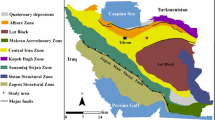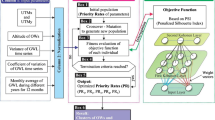Abstract
Unsupervised clustering (e.g., K-means) and supervised machine learning [e.g., support vector machines (SVMs)] methods can be used in data-driven classification and predictive mapping of mineral prospectivity. In this study, the conceptual model of porphyry-type Cu deposits in Varzaghan district, Northwest Iran, was utilized to translate mineralization-related processes into mappable targeting criteria, resulting in six evidence layers derived from geochemical, geological, structural and remote sensing data. Then, traditional K-means clustering (KMC) method and a supervised SVM were employed to construct GIS-based mineral prospectivity maps. One of the challenging issues for generation of mineral prospectivity maps using clustering algorithms is to select suitable cluster centers (called centroids) in order to circumscribe the similar spatial features into meaningful clusters. Machine learning methods are strongly sensitive to hyperparameter values that contribute to prediction, as the prediction accuracy can significantly enhance when the optimized hyperparameters are calibrated to training procedure. To reach these goals, a genetic algorithm was incorporated into K-means and SVM in order to automatically select the optimized cluster centroids and tuned hyperparameters, respectively, and two new prospectivity models namely GKMC and genetic-based SVM were then generated. To evaluate the performance accuracy in training procedures of SVM and genetic-based SVM, K-fold cross-validation and confusion matrix were employed. Moreover, success-rate curves were plotted to compare the overall performance of unsupervised clustering models comprising KMC and GKMC and also supervised machine learning models comprising SVM and genetic-based SVM for detection of favorable areas associated with porphyry-type Cu mineralization. The results suggested the superiority of genetic-based SVM model over other models.











Similar content being viewed by others
Code availability
The codes that support the findings of this study are available at figshare.com with the private link [https://figshare.com/s/3b36f43d714a2d6485d3].
References
Aghazadeh M, Hou Z, Badrzadeh Z, Zhou L (2015) Temporal–spatial distribution and tectonic setting of porphyry copper deposits in Iran: constraints from zircon U-Pb and molybdenite Re–Os geochronology. Ore Geol Rev 70:385–406
Akbari S, Ramazi H, Ghezelbash R, Maghsoudi A (2020) Geoelectrical integrated models for determining the geometry of karstic cavities in the Zarrinabad area, west of Iran: combination of fuzzy logic, CA fractal model and hybrid AHP-TOPSIS procedure. Carbonates Evaporites 35:1–16
Bigdeli A, Maghsoudi A, Ghezelbash R (2022) Application of self-organizing map (SOM) and K-means clustering algorithms for portraying geochemical anomaly patterns in Moalleman district, NE Iran. J Geochem Explor 233:106923
Bonham-Carter GF (1989) Weights of evidence modeling: a new approach to mapping mineral potential. Stat Appl Earth Sci 89:171–183
Campbell C (2002) Kernel methods: a survey of current techniques. Neurocomputing 48:63–84
Carranza E, Hale M, Faassen C (2008) Selection of coherent deposit-type locations and their application in data-driven mineral prospectivity mapping. Ore Geol Rev 33:536–558
Carranza EJM, Laborte AG (2016) Data-driven predictive modeling of mineral prospectivity using random forests: a case study in Catanduanes Island (Philippines). Nat Resour Res 25:35–50
Carranza EJM (2008) Geochemical anomaly and mineral prospectivity mapping in GIS. Elsevier
Chiang MM-T, Mirkin B (2007) Experiments for the number of clusters in k-means. In Portuguese conference on artificial intelligence, pp 395–405
Cox DP, Singer DA (1986) Mineral deposit models. US Government Printing Office Bulletin
Daviran M, Maghsoudi A, Cohen DR, Ghezelbash R, Yilmaz H (2020) Assessment of various fuzzy c-mean clustering validation indices for mapping mineral prospectivity: combination of multifractal geochemical model and mineralization processes. Nat Resour Res 29(1):229–246
Daviran M, Maghsoudi A, Ghezelbash R, Pradhan B (2021) A new strategy for spatial predictive mapping of mineral prospectivity: Automated hyperparameter tuning of random forest approach. Comput Geosci 148:104688
Daviran M, Parsa M, Maghsoudi A, Ghezelbash R (2022) Quantifying uncertainties linked to the diversity of mathematical frameworks in knowledge-driven mineral prospectivity mapping. Nat Resour Res 1–17
Daviran M, Shamekhi M, Ghezelbash R, Maghsoudi M (2022) Landslide susceptibility prediction using artificial neural networks, SVMs and random forest: hyperparameters tuning by genetic optimization algorithm. Int J Environ Sci Technol. https://doi.org/10.1007/s13762-022-04491-3
de Palomera PA, Van Ruitenbeek FJ, Carranza EJM (2015) Prospectivity for epithermal gold–silver deposits in the Deseado Massif, Argentina. Ore Geol Rev 71:484–501
Fogel DB (1994) An introduction to simulated evolutionary optimization. IEEE Trans Neural Netw 5:3–14
Ghezelbash R, Maghsoudi A (2018) A hybrid AHP-VIKOR approach for prospectivity modeling of porphyry Cu deposits in the Varzaghan District. NW Iran Arab J Geosci 11:275
Ghezelbash R, Maghsoudi A (2018) Application of hybrid AHP-TOPSIS method for prospectivity modeling of Cu porphyry in Varzaghan district. Iran J Geosci 28(109):33–42
Ghezelbash R, Maghsoudi A, Carranza EJM (2019) An improved data-driven multiple criteria decision-making procedure for spatial modeling of mineral prospectivity: adaption of prediction–area plot and logistic functions. Nat Resour Res 28:1299–1316
Ghezelbash R, Maghsoudi A, Carranza EJM (2019) Performance evaluation of RBF-and SVM-based machine learning algorithms for predictive mineral prospectivity modeling: integration of SA multifractal model and mineralization controls. Earth Sci Inf 12(3):277–293
Ghezelbash R, Maghsoudi A, Carranza EJM (2019) Mapping of single-and multi-element geochemical indicators based on catchment basin analysis: application of fractal method and unsupervised clustering models. J Geochem Explor 199:90–104
Ghezelbash R, Maghsoudi A, Daviran M (2019) Implementation of fuzzy-AHP and fuzzy-GAMMA approaches for discovering the prospectivity areas of Au mineralization in Takhte-Soleyman district
Ghezelbash R, Maghsoudi A, Carranza EJM (2020) Sensitivity analysis of prospectivity modeling to evidence maps: enhancing success of targeting for epithermal gold, Takab district. NW Iran Ore Geol Rev 120:103394
Ghezelbash R, Maghsoudi A, Carranza EJM (2020) Optimization of geochemical anomaly detection using a novel genetic K-means clustering (GKMC) algorithm. Comput Geosci 134:104335
Ghezelbash R, Maghsoudi A, Bigdeli A, Carranza EJM (2021) Regional-scale mineral prospectivity mapping: support vector machines and an improved data-driven multi-criteria decision-making technique. Nat Resour Res 30(3):1977–2005
Goldberg D (1989) Genetic algorithms in search, optimization, and machine learning. Addison-Wesley, Reading (Objective Function Value [Eq.(18)]).
Guo H, Zhu K, Gao S, Liu T (2006) An improved genetic k-means algorithm for optimal clustering. In: Sixth IEEE International Conference on Data Mining-Workshops (ICDMW'06), pp 793–797
Jain AK (2010) Data clustering: 50 years beyond K-means. Pattern Recognit Lett 31:651–666
Jamali H, Mehrabi B (2015) Relationships between arc maturity and Cu–Mo–Au porphyry and related epithermal mineralization at the Cenozoic Arasbaran magmatic belt. Ore Geol Rev 65:487–501
Kavzoglu T, Colkesen I (2009) A kernel functions analysis for support vector machines for land cover classification. Int J Appl Earth Obs Geoinf 11:352–359
Kreuzer OP, Etheridge MA, Guj P, McMahon ME, Holden DJ (2008) Linking mineral deposit models to quantitative risk analysis and decision-making in exploration. Econ Geol 103:829–850
Krishna K, Murty MN (1999) Genetic K-means algorithm. IEEE Trans Syst Man Cybern Part B (Cybern) 29:433–439
Krishna K, Narasimha Murty M (1999) Genetic K-means algorithm. IEEE Trans Syst Man Cybern Part B (Cybern) 29:433–439
Lisitsin V, González-Álvarez I, Porwal A (2013) Regional prospectivity analysis for hydrothermal-remobilised nickel mineral systems in western Victoria, Australia. Ore Geol Rev 52:100–112
Maghsoudi A, Rahmani M, Rashidi B (2005) Gold deposits and indications of Iran Pars (Arian Zamin) geology research center
McCuaig TC, Beresford S, Hronsky J (2010) Translating the mineral systems approach into an effective exploration targeting system. Ore Geol Rev 38:128–138
Mehrpartou M, Aminifazl A, Radfar J (1992) Geological map of Iran 1: 100,000 series. Geological Survey of Iran, Varzaghan
Mirkin B (2012) Clustering: a data recovery approach. CRC Press
Pirajno F (2012) Hydrothermal mineral deposits: principles and fundamental concepts for the exploration geologist. Springer
Porwal A, Carranza EJM (2015) Introduction to the Special Issue: GIS-based mineral potential modelling and geological data analyses for mineral exploration. Elsevier
Porwal A, Carranza E, Hale M (2003) Artificial neural networks for mineral-potential mapping: a case study from Aravalli Province, Western India. Nat Resour Res 12:155–171
Rodriguez-Galiano V, Sanchez-Castillo M, Chica-Olmo M, Chica-Rivas MJOGR (2015) Machine learning predictive models for mineral prospectivity: an evaluation of neural networks, random forest, regression trees and support vector machines. Ore Geol Rev 71:804–818
Rudolph G (1994) Convergence analysis of canonical genetic algorithms. IEEE Trans Neural Netw 5:96–101
Singer DA (2010) Progress in integrated quantitative mineral resource assessments. Ore Geol Rev 38:242–250
Vapnik V (1998) Statistical learning theory. Wiley, New York
Wang S, Li Y, Shao Y, Cattani C, Zhang Y, Du S (2017) Detection of dendritic spines using wavelet packet entropy and fuzzy support vector machine. CNS Neurol Disord Drug Targets (Formerly Current Drug Targets-CNS & Neurological Disorders) 16(2):116–121
Wang SH, Jiang X, Zhang YD (2021) Multiple sclerosis recognition by biorthogonal wavelet features and fitness-scaled adaptive genetic algorithm. Front Neurosci. https://doi.org/10.3389/fnins.2021.737785
Wu C-H, Tzeng G-H, Goo Y-J, Fang W-C (2007) A real-valued genetic algorithm to optimize the parameters of support vector machine for predicting bankruptcy. Expert Syst Appl 32:397–408
Xu R, Wunsch D (2005) Survey of clustering algorithms. IEEE Trans Neural Netw 16:645–678
Zuo R, Carranza EJM (2011) Support vector machine: a tool for mapping mineral prospectivity. Comput Geosci 37:1967–1975
Zuo R, Zhang Z, Zhang D, Carranza EJM, Wang H (2015) Evaluation of uncertainty in mineral prospectivity mapping due to missing evidence: a case study with skarn-type Fe deposits in Southwestern Fujian Province, China. Ore Geol Rev 71:502–515
Author information
Authors and Affiliations
Contributions
RG: Wrote and revised the context of manuscript and contributed to generate MATLAB and GIS-based models as well as interpretation of the results. AM: Contributed to the interpretation of the results and revised the manuscript. MS: Wrote the context of manuscript and contributed to provide the algorithms applied in MATLAB. BP: Revised the manuscript. MD: Contributed to provide the algorithms applied in MATLAB and interpretation of the results.
Corresponding author
Ethics declarations
Conflict of interest
The authors declare that they have no conflict of interest.
Additional information
Publisher's Note
Springer Nature remains neutral with regard to jurisdictional claims in published maps and institutional affiliations.
Rights and permissions
Springer Nature or its licensor holds exclusive rights to this article under a publishing agreement with the author(s) or other rightsholder(s); author self-archiving of the accepted manuscript version of this article is solely governed by the terms of such publishing agreement and applicable law.
About this article
Cite this article
Ghezelbash, R., Maghsoudi, A., Shamekhi, M. et al. Genetic algorithm to optimize the SVM and K-means algorithms for mapping of mineral prospectivity. Neural Comput & Applic 35, 719–733 (2023). https://doi.org/10.1007/s00521-022-07766-5
Received:
Accepted:
Published:
Issue Date:
DOI: https://doi.org/10.1007/s00521-022-07766-5




